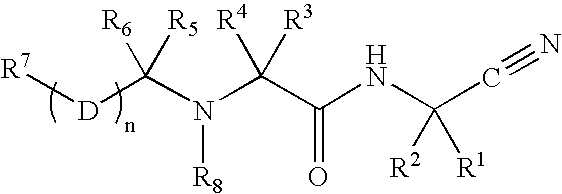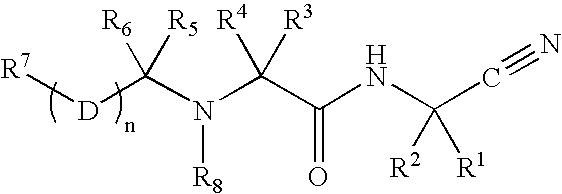Cathepsin cysteine protease inhibitors
a cathepsin cysteine protease and protease inhibitor technology, applied in the field of cathepsin cysteine protease inhibitors, can solve the problems of low bone density of a large segment of the older population, weaker bone structure, and high risk of fracture, so as to prevent cathepsin dependent conditions and treat and/or prevent the effect of cathepsin dependent conditions
- Summary
- Abstract
- Description
- Claims
- Application Information
AI Technical Summary
Benefits of technology
Problems solved by technology
Method used
Image
Examples
example 1
Synthesis of N1-(cyanomethyl)-N2-(2,2,2-trifluoro-1-phenylethyl)-L-leucinamide
[0747]
[0748] To a solution of L-leucine methyl ester hydrochloride (975 mg, 5.37 mmol) in dichloromethane (30 mL) was added 2,2,2-trifluoroacetophenone (0.75 mL, 5.34 mmol) and diisopropylethylamine (3.5 mL, 20 mmol). TiCl4 (0.55 mL, 5.0 mmol) in 0.45 mL dichloromethane was added dropwise, and the mixture was stirred overnight. Additional TiCl4 (0.4 mL, 3.6 mmol) was then added and the mixture was stirred 3 h. A solution of NaCNBH3 (1050 mg, 16.7 mmol) in MeOH (20 mL) was added and the mixture was stirred 2 h. Poured into 1N NaOH and extracted with ethyl acetate (2×). The organic phase was washed with 1N NaOH and brine, then dried over MgSO4 and evaporated. Purification by ISCO column chromatography (gradient 30% to 90% ethyl acetate / hexanes) provided methyl N-(2,2,2-trifluoro-1-phenylethyl)-L-leucinate.
[0749] To a room temperature solution of methyl N-(2,2,2-trifluoro-1-phenylethyl)-L-leucinate (150 mg,...
example 2
Synthesis of N2-[1-(4-bromophenyl)-2,2,2-trifluoroethyl]-N′-(cyanomethyl)-L-leucinamide
[0751]
Using the method of Example 1, N2-[1-(4-bromophenyl)-2,2,2-trifluoroethyl]-N1-(cyanomethyl)-L-leucinamide was prepared. MS (−ESI): 403.9, 405.9 [M−1]−
example 3
Synthesis of N1-(cyanomethyl)-N2-[2,2,2-trifluoro-1-(4′-piperazin-1-yl-1,1′-biphenyl-4-yl)ethyl]-L-leucinamide
[0752]
[0753] To N2-[1-(4-bromophenyl)-2,2,2-trifluoroethyl]-N-(cyanomethyl)-L-leucinamide (242 mg, 0.60 mmol), and 4-[4-(tert-butoxycarbonyl)-1-piperazinyl]phenylboronic acid (220 mg, 0.72 mmol) in DME (3 mL) under dry nitrogen was added 2M aqueous sodium carbonate (0.9 mL, 1.8 mmol) followed by the catalyst PdCl2(dppf) (63 mg, 0.077 mmol). The reaction was heated to 85° C. for 18 hours. Water was added and the product was extracted with EtOAc, the organic layer was dried over Na2SO4 and concentrated in vacuo. The crude product was purified by chromatography using EtOAc in hexane to afford tert-butyl (4′-(1-[((1S)-1-{[(cyanomethyl)amino]carbonyl}-3-methylbutyl)amino]-2,2,2-trifluroethyl}-1,1′-biphenyl-4-yl)-1-piperazinecarboxylate.
[0754] To tert-butyl (4′-{1-[((1S)-1-{[(cyanomethyl)amino]carbonyl}-3-methylbutyl)amino]-2,2,2-trifluroethyl )-1,1′-biphenyl4-yl)- -piperazineca...
PUM
| Property | Measurement | Unit |
|---|---|---|
| Mass | aaaaa | aaaaa |
| Density | aaaaa | aaaaa |
| Pharmaceutically acceptable | aaaaa | aaaaa |
Abstract
Description
Claims
Application Information
 Login to View More
Login to View More - R&D
- Intellectual Property
- Life Sciences
- Materials
- Tech Scout
- Unparalleled Data Quality
- Higher Quality Content
- 60% Fewer Hallucinations
Browse by: Latest US Patents, China's latest patents, Technical Efficacy Thesaurus, Application Domain, Technology Topic, Popular Technical Reports.
© 2025 PatSnap. All rights reserved.Legal|Privacy policy|Modern Slavery Act Transparency Statement|Sitemap|About US| Contact US: help@patsnap.com



